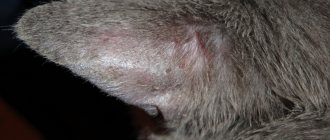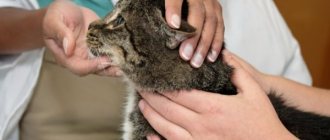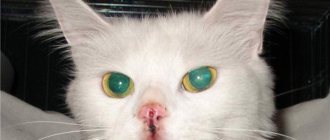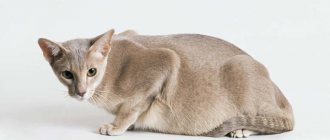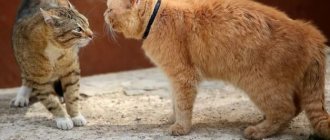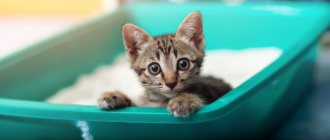Sometimes, quite by accident, when you take your beloved pet in your arms, you realize that something is wrong. On your favorite fluffy face you can see frightening bald patches. And a whirlwind of questions immediately arises in my head. Where did this come from? What to do? What is this? Is this treatable? In fact, you can calm yourself down. This pathology is quite common among cats and can be treated quite successfully. You can find out more about this in this article.
Having discovered bald spots, it is important to take timely action!
How to distinguish normality from pathology?
Baldness of skin areas is not always caused by pathological reasons.
In some cases, hair loss occurs in cats that have recently given birth to kittens. The problem arises due to an unbalanced diet. A nursing mother needs increased nutrition and vitamin intake. In animals of smooth-haired breeds, bald spots can occur as a result of regular licking of the fur, due to genetic predisposition.
Hair loss may indicate nervous strain that has arisen in the cat as a result of moving or having a new pet. Such situations are stressful for the pet; treatment is by taking sedatives.
Vitamin deficiency can be another reason for hair loss.
Bald patches near the ears
The development of characteristic bald spots near the ears of an animal (periacular alopecia) occurs in a cat for the same reasons as hair loss above the eyes.
To make a diagnosis and prescribe treatment, your pet should be taken to a veterinary clinic, where the doctor:
- will conduct a visual inspection,
- will prescribe a series of tests,
- take scrapings from the skin,
- Based on the data obtained, he will prescribe treatment.
How to treat baldness
How to treat alopecia largely depends on the diagnosis. Many mustachioed owners, when they see a bald area, scream in horror - “deprivation!” and begin to look for something to anoint. The approach is completely wrong.
For feline alopecia, complex treatment is most often prescribed. Local therapy is indicated if there is a bacterial or fungal infection.
The algorithm is as follows:
- Treatment of the underlying disease that causes hair loss in cats.
- If skin parasites are identified, drops, tablets, and shampoos are prescribed to get rid of them. The prognosis is good if antiparasitic treatments are carried out regularly.
- For infections, a course of antibiotics.
- In case of an allergic reaction, the allergen is eliminated. If your cat has a food allergy, review the diet and eliminate it. The prognosis is good if the food is chosen correctly. If the allergen is not identified, the prognosis for recovery is cautious.
- If it's stress, the cause should be ruled out. With proper behavior correction, the prognosis is satisfactory. The therapy is long-term and requires patience from the owner.
- If tumors occur, surgical intervention is required. Timely surgery gives the right to make a positive prognosis. In advanced cases, the animal is not operated on.
Regardless of the reason, it is additionally necessary to strengthen the animal’s immunity. Sometimes the question arises about selecting a diet in accordance with age, state of health, and physiology.
Bald patches in a cat: how to distinguish normal from pathology?
If your cat begins to develop bald patches in the area of the ears or around the eyes, then this is not a reason to worry. A similar phenomenon is called periacular alopecia and occurs quite often in quadrupeds.
This disease is not accompanied by itching or burning. In each case, the cause of the disease is different. Having determined why cats have bald patches near the ears, it will be much easier to overcome the skin disease and return your pet’s coat to an attractive appearance.
Why does baldness occur?
There are many factors that provoke the manifestation of alopecia. Most often, this phenomenon occurs in short-haired cats. Before moving directly to the treatment of pathology, it is necessary to understand what caused the disease.
The most common cause of a receding hairline is food allergies. Most often, cats are allergic to foods such as lamb, cereals, and proteins of plant or food origin.
By adjusting your pet's diet, you can improve its health.
Hormonal imbalance can also cause the formation of bald spots in a cat. In this case, hair falls out not only in the ears or around the eyes, but also in other areas. With hormonal imbalance, baldness occurs in the abdomen, chest, hind legs, armpits, and also in the area near the anus.
In this case, the owner needs to provide his pet with the most peaceful living environment possible. Calming medications intended for cats will also have a beneficial effect on the health of your four-legged friend.
Alopecia sometimes results from dermatomycosis. In this case, increased hair loss is noticed in the area of the eyes and ears. The shape of bald patches with dermatomycosis is ring-shaped or rounded.
Treatment of bald patches in cats is carried out using special antifungal agents.
Other causes of the disease
In rare cases, the factor that causes the appearance of bald patches is the following serious illnesses:
- Acromegaly;
- Problems with the thyroid gland (hypothyroidism);
- Diabetes;
- The period after castration;
- Hyperfunction of the adrenal cortex (Cushing's syndrome);
Other pathologies can also provoke the formation of bald spots. Some cats develop skin diseases due to allergies to medications. The presence of parasitic diseases also sometimes leads to alopecia.
In this case, it will be easy to notice the presence of parasites, since the influence of mites, lichen and cat scabies will immediately be reflected in the condition of the coat. In rare cases, bald patches appear in the presence of benign or malignant tumors. Hereditary factor is another reason for cat baldness.
Features of treatment
You can eliminate bald patches in a cat above the eyes or in another problem area by addressing the root cause of the disease.
If parasites are the cause of the skin disease, it is necessary to provide the pet with proper treatment.
If local baldness occurs as a result of allergies, then it is necessary to limit contact with allergens. A hypoallergenic diet will improve your cat's health. In this case, the veterinarian prescribes the animal to take antiallergic drugs and immunostimulants.
When an animal has problems with the endocrine system, then it is recommended to select special treatment. Taking hormones will improve the cat's health and return its coat to its previous appearance.
Preventive measures
Preventing skin disease such as alopecia is not difficult. To do this, you must adhere to the following measures:
- Observe hygiene rules. The owner must remember to inspect the cat’s fur (especially if he is often outdoors) for ticks and other parasites and deal with them in a timely manner;
- Provide the animal with a balanced diet. The cat's diet should contain vitamins and other useful microelements;
- Carry out routine vaccinations for your pet;
- Visit the veterinarian periodically. During the examination, a specialist can identify possible pathologies;
There is no need to “sound the alarm” if your beloved cat has bald patches on his skin. This phenomenon is not uncommon for most cats. If you find the cause of the pathology in a timely manner and carry out treatment, it is easy to return your pet to vigor and health.
Dermatomycosis
Animals of any age and breed can become infected with it after contact with infected cats. A tick can live in a pet’s body for a long time and not appear. To activate the disease, a provoking factor is needed, for example, a decrease in immunity.
As a result, the tick in the cat’s body begins to lead active life activities, having a negative impact on the overall health.
In addition to bald patches near the ears, there may be redness of the skin, peeling in the eye area, skin rashes that look like small pustules, as well as the formation of small ulcers and bleeding wounds on the skin.
How to treat alopecia in cats
The nature of the treatment depends on the cause that provoked the appearance of local bald patches. If the disease is allergic, it is necessary to isolate the animal from exposure to allergens. “The veterinarian should prescribe immunostimulants and antiallergic drugs to the cat.” In addition, the animal must adhere to a special hypoallergenic diet.
If alopecia is caused by parasites, the animal is recommended to use special sprays, gels, and ointments that have antiparasitic properties. In addition, the cat should additionally take vitamin complexes to stimulate immune function.
Abscess and pyoderma, which also provoke alopecia, are treated by treating the skin with systemic and external antibiotics, as well as antiseptics.
Naturally, treatment will directly depend on the cause of baldness. In the case of a banal allergic reaction, it is enough just to protect the pet from the source of the pathogen. In this case, the veterinarian will prescribe special antiallergic drugs and immunostimulants. Also, do not forget about the special diet that you will have to adhere to during therapy.
If baldness is caused by parasites, then it is important for your pet to use different ointments and sprays that can get rid of this problem once and for all. Among other things, the pet must also take vitamin complexes to maintain its strength.
In case of endocrine alopecia, it is necessary to take special hormonal medications. If baldness is psychogenic in nature, it is necessary to take special sedatives and sedatives.
Bald patches in cats above the eyes and near the ears are a serious but treatable pathology. For each animal, the veterinarian selects individual therapy depending on the causes of the disease:
- 1. If the pathology is caused by an allergy, the cat must be isolated from contact with the allergen. After which the veterinarian will prescribe antiallergic drugs and drugs to enhance immunity. In case of food allergies, the animal is prescribed a diet.
- 2. If parasites are detected, the cat should be treated with special anti-parasitic agents and additionally given drugs to enhance immunity.
- 3. In case of abscesses, the cat must undergo a course of treatment with antiseptics and antibiotics.
- 4. In case of endocrine disorders, the doctor will prescribe hormonal medications.
- 5. If a cat has a malfunction of the sebaceous glands, it is necessary to use antiseborrheic agents and retinoids.
- 6. In case of weakened condition, vitamins and a special diet are prescribed.
Chinchillas in Belarus.
Are you sure it's an allergy? Just from the description, this is the first sign of some kind of fungal disease. Starts from the paws, muzzle and around the eyes. After this, baldness moves to the back of the head and body. I recommend blowing all the wool to see if there are still such places. If yes, go to the pharmacy to buy exoderil and apply it. Of course, you can take him to the vet first, but this may not be of any use.
Especially if not one has. Allergies in shinshas are, in principle, an extremely rare disease, as far as I understand. And if two people have peeling noses and paws, then something is clearly contagious. So most likely a fungus.
We took it to the vet, he said that we needed to apply Triderm ointment. after a couple of weeks, the paw and nose were overgrown, but after a week the second paw began to peel around the eye. (Shinsha doesn’t have it yet), but Masya has nothing yet, but her nose is starting to peel (((
A peeling nose is one of the first signs. I still recommend trying Exoderil. If only because the ointments are greasy, they make the fur stick together. And besides, the bastard can lick them off. And exoderil is a solution. It is not difficult to smear with it: we take a little into a syringe (without a needle, of course) and simply drip it onto bare skin, and also treat 0.5 - 1 cm of skin around it. It’s true that it’s very difficult with the eyes. You can simply squeeze a little bit out of the syringe (just so that a small drop appears on the nose) and smear it around the eye. Those. simply block the spread of the fungus.
It’s a strange vet... chinchillas cannot be smeared with ointment at all. only solutions and gels. Even now, add a little medical sulfur to the sand, as an antifungal, and smear it with exoderil (solution).
this ointment (triderm) helps (I can post photos before and after use). but I’m afraid to apply it near the eye so that there are no problems with vision. (the paw and eye are the sick Shinsh, and Masya, near the beginning of her mustache, also has a nose without hair) so, Masya has no hair in places
Source
Causes of baldness
First, you need to figure out why your cat's ears are going bald. In fact, this symptom can be triggered by anything, from allergies to stress, and only a veterinarian can determine the real cause.
shutterstock
However, there are several common factors:
- Allergic reactions;
- Skin infections and parasites;
- Psychogenic influence;
- Hormonal disorders;
- Heredity.
Allergy
Allergic reactions can occur due to toxic substances and various environmental factors; A new food or medication can also provoke an allergy, as a result of which the hair on the cat’s ears falls out, the shells themselves turn red, become covered with a rash, and begin to itch unbearably, which is why the animal scratches its ears too much. Treatment is carried out in only one way - isolating the allergen from the cat's diet or environment and using medications prescribed by the veterinarian.
Skin infections and parasites
- Otodectosis or scabies. Otodectosis occurs due to infection with ear mites, which can cause purulent otitis media. The ears become red and itchy, and the itching can spread down to the neck, causing the cat to try to relieve it by scratching itself excessively. This is what causes baldness.
- Ringworm and other fungal infections. Fungi are very dangerous, so they try to exclude lichen as the cause of baldness in the first place. Emergency veterinary assistance is especially necessary if ear hair loss is accompanied by redness and rash.
- Viruses. Viral infections that cause hair loss in a cat's ears can affect any organ, from respiratory diseases to eye lesions. Only a specialist will help determine what exactly the animal is sick with and choose the right medications; self-medication can only worsen the cat’s condition.
shutterstock
Stress
Emotional turmoil does not always have a very good effect on animals. A change in the environment surrounding people can lead to the fact that their nervous system cannot stand it: the cat may refuse to eat, begin to hide, the owners may notice that its hair is falling out (on the ears and not only). If symptoms have recently appeared, you can try to calm your pet yourself. For long-term effects of stress, it is better to consult a specialist.
Hormonal disorders in the cat's body
Very often, ears go bald when hormonal problems are diagnosed. One of the manifestations of such disorders is hyperthyroidism - in 30% of cases, in addition to other symptoms, the ears become bald. A cat may also have hypothyroidism. Both of these diseases are associated with dysfunction of the thyroid gland. With diabetes, the hair throughout the body begins to dull and fall out.
Heredity.
Sometimes receding hairlines on and behind the ears appear as a result of a gene mutation and are passed on from generation to generation. Perhaps the ancestors of the balding cat had individuals with similar bald spots? In this case, you don’t have to worry about the health of your pet’s ears.
shutterstock
Dangerous complications
Overgrooming is a fairly serious deviation that can lead to negative consequences. Lack of timely and correct assistance can lead to:
- The formation of wool plugs in the stomach and intestines of cats, leading to their obstruction and accumulation of feces.
- The appearance of non-healing wounds, ulcers, scratches, which are open gates for various types of infections. In severe cases, this can lead to the formation of necrotic lesions. To prevent such situations, you need to treat wounds with antiseptic sprays and ointments, cover them with bandages and plasters.
- Disturbances in the natural growth of the coat, as well as deterioration of its protective functions.
Overgrooming is a pathology that requires a special approach, as well as great responsibility. If its cause was physiological health problems, then treatment should be aimed at eliminating them. After recovery from the underlying disease, pathological licking will go away on its own.
In the article I will describe in detail the reasons why a cat licks itself until it becomes bald, and why it licks human skin. I'll tell you what this entails. I will clarify the treatment of overgrooming in cats. I will dwell in detail on why cats lick their owner and whether it is dangerous for humans.
Licking fur is a normal state for a cat. But everything should happen in moderation. If your pet is licking its fur excessively to the point of baldness, you need to think about it. Most often this is a sign of some kind of problem. Let's look at the most common of them.
Stress
Unusual and even inappropriate behavior of a cat is not always a consequence of deteriorating physical health of the animal. Sometimes the reason has an emotional basis.
A number of situations can cause stress in a pet:
- relocation of one of the family members;
- rearrangement of furniture;
- loss of a pet's favorite toy;
- the appearance of another animal in the house and much more.
A cat's life is predictable and orderly, and anything that brings change is not always good for the pet.
Owners often try to impose rules on the cat.
Licking causing increased skin balding is abnormal
But a freedom-loving animal may have its own thoughts on this matter. It is impossible to act impudently here, and you will achieve nothing. It can cause emotional stress. It is better to find contact with the pet, some kind of mutual solution.
Compromise is the only true way out of the situation.
Itching
If your pet feels itchy, it begins to actively lick these places. Moreover, there is a pattern: a cat licks wounds more accurately than itches. If the licking area is large, it means the cat is itching there. Moreover, attentive owners have noticed that when itching, animals most often lick their back, stomach and other parts of the body.
Allergy
Mostly typical for cats. For example, for dry food, which the animal cannot eat in nature, or for its individual components. Sometimes, of course, medications cause side effects. But this happens less often. You can try changing your diet. You need to consult a specialist; you may need to take antihistamines.
Damage to the skin
Animals have no other way to restore health than to do it themselves. And licking wounds is proof of this. The pet instinctively tries to help itself. But if you have already applied the ointment, it is better to exclude this possibility. Apply a bandage or otherwise limit the animal’s access to the wound site. You can wear a special collar.
Movement restrictions
Cats by nature do not like closed doors. They will constantly be tormented by the question of what is happening in the closed area. Imagine that a person was imprisoned in an apartment and forbidden to leave. Over time, he will begin to tear out his hair. Especially if you previously liked to walk outside for a long time. And animals are no exception.
Although a cat can make do with a small space to exist, too little space is also bad. It is recommended to consider the interests of the pet. This is a living creature that also has its own needs.
Causes of the disease
Alopecia (baldness) in a cat can have a different nature. In most cases, the appearance of characteristic bald patches near the ears and above the eyes is associated with a food allergy affecting the animal. Typical allergens are the following:
- vegetable and animal proteins;
- cereals;
- mutton.
In addition to the allergic factor, a psychogenic factor contributes to the appearance of bald spots in cats. This type of disease is symptomatic of the formation of foci of alopecia on the following parts of the animal’s body:
- hips;
- inner surface of paws;
- stomach.
If the veterinarian confirms the psychogenic nature of the appearance of bald patches, the pet owner should eliminate the cause that caused the stress, and then resort to the use of sedatives intended for animals. If baldness is accompanied by an inflammatory process or dermatitis, it is necessary to treat them as well.
https://youtube.com/watch?v=bBlDWl9n6mc
The appearance of bald patches near the ears and above the eyes may indicate that the cat has a hormonal disorder. Symptoms of this disease can also appear on the following parts of the body:
- on the stomach;
- in the area of the hind limbs;
- on the chest and abdominal walls;
- in the anogenital part of the body;
- in the armpits of a pet.
So-called “endocrine alopecia” in cats may also indicate the following severe systemic diseases:
- hypothyroidism (thyroid dysfunction);
- Cushing's syndrome (hyperfunction of the adrenal cortex);
- post-castration syndrome - with this pathology, the animal’s neck becomes bald, and a kind of collar is formed;
- acromegaly;
- diabetes.
The list of causes of baldness in cats would be incomplete without mentioning a disease such as dermatomycosis. A similar disease is a progressive alopecia, the areas of localization above the eyes, near the ears and on other parts of the animal’s body have a round or ring-shaped shape.
The skin in the affected areas is characterized by increased dryness, but the pet is not bothered by itching. Ringworm occurs due to a fungal infection that affects the hair or epidermis of the animal. Treatment of the disease, accordingly, is carried out with special antimycotic drugs.
Rare causes of bald patches in the ears and above the eyes in cats include the following:
- neoplasms of benign and malignant origin;
- allergic reaction to certain medications;
- hereditary factor;
- various parasitic diseases (lichen, mites, cat scabies).
Scabies
Scabies is another type of mite infestation that causes severe itching, especially around the face, ears, and neck. The skin in the affected areas experiences significant hair loss, and the skin usually begins to develop a grayish-yellow crust, similar to severe eczema.
Feline mange is divided into two types: notohedral and demodectic. Either type is diagnosed by taking a skin scraping from the affected area and examining it under magnification for the presence of mites. To treat mange, you need to trim off the long fur and apply a layer of lime sulfur once a week until subsequent skin scrapings show that the mites are gone. Treatments can be repeated six to eight times to cure the infestation.
Prevention measures
To protect your family pet from skin diseases that are accompanied by baldness, it is necessary to provide proper care for the cat:
- The first and most important thing is preventive examinations. You can do them yourself. While bathing, brushing, and playing with your cat, it is very convenient to check the condition of its coat. Regular monitoring will ensure that you do not miss the appearance of alarming symptoms.
- Timely vaccinations against infectious diseases will improve your pet's health.
- Regular (once every 4-5 months) antiparasitic treatment is a shield against skin diseases.
- Deworming medications are required for all cats.
- A calm and friendly atmosphere in the family without stress and scandals is useful not only for people, but also for cats.
- If the cat is about to move, change owners, or the house is about to be renovated, a good solution would be to use sedatives.
- You should not allow contact with unfamiliar animals - they can be carriers of the causative agent of alopecia.
- A balanced diet and proper nutrition are the key to a healthy cat.
To preserve not only the health, but also the beauty of your pet, it is important to be an attentive and sensitive owner. Timely adoption of measures will eliminate the disease at the very beginning - and this will relieve stress from both the cat and the owner.
And it is important to always remember that self-medication can seriously aggravate the course of the disease.
Causes and treatment of baldness in cats
Any cat health problem requires increased attention and involvement of the owner. Periocular alopecia is no exception - partial loss of hair, in which the ears and other parts of the pet’s body become bald. Often this phenomenon is caused by dangerous reasons, and it itself can become a sign of another, more serious disease.
Physiological causes of hair loss
Moderate hair loss is a natural process that does not always require treatment. The reason for this phenomenon is annual molting, during which the old hair falls out and a new one grows in its place. It is noteworthy that cats lose much more fur than male cats.
Other causes of physiological hair loss:
- chafing collars, bandages or harnesses;
- bathing more often than once every 5 months;
- bathing with cheap human shampoos and detergents not intended for these purposes;
- stressful situation;
- age-related baldness in the area of the eyes, ears, paws, loss of mustache.
These causes do not pose any danger to the cat’s health and do not require treatment. As a rule, after a certain time, the fur grows back if the animal is not old.
Signs of pathology
Alopecia is an anomaly that occurs due to a malfunction in the body and requires medical intervention. Large bald areas and bald spots on the pet's body should alert the owner.
Signs of pathology:
- severe hair loss during scratching and walking;
- the hair falls out in clumps, leaving bald areas in the area of the ears, back, tail and other parts of the body;
- the hair on one side is thicker than on the other;
- the skin on bald areas is not pinkish, as it should be normally, but red;
- peeling, ulcers, wounds and scabs are noticeable on the skin;
- the animal scratches the bald spot vigorously, possibly to the point of bleeding;
- touching the skin causes anxiety in the cat or, conversely, apathy.
If you notice one or more of the listed symptoms in your pet, take immediate action.
Remember that timely treatment is much more effective than therapy in severe stages of the disease.
Causes of the disease
Baldness in cats, not associated with physiological hair loss, occurs for a number of reasons. It is not always possible to identify them by appearance, so a serious examination and appropriate tests may be necessary. In each individual case of baldness in cats, the veterinarian determines the possible causes and treatment individually.
Most often, pathology is caused by 3 groups of reasons:
In addition to these reasons, baldness in a cat can occur due to tumor processes or poor heredity. It is noteworthy that some hairless cat breeds were developed by crossing related individuals.
Vitamin deficiency, viral diseases, ultraviolet radiation and some chronic diseases associated with the functioning of the gastrointestinal tract and liver also negatively affect the condition of the pet’s coat.
In order to figure out why your cat is going bald, you need to consult a specialist.
Diagnosis of the disease
The task of the owner who has noticed that his cat is balding in the ears, back, abdomen and other parts of the body is to contact a veterinarian for a subsequent examination and diagnosis of the root cause that caused this problem.
To diagnose alopecia, the following measures may be necessary:
- analysis of medical history;
- visual examination of the skin, ear and mucous membranes of the cat;
- microbiological examination of wool bulbs;
- blood tests;
- analysis of epidermal scraping;
- hormone analysis;
- X-ray examination.
All these methods together will help identify the presence of a disease that negatively affects the cat’s fur.
Treatment options
Having determined the diagnosis, the specialist prescribes treatment. It is aimed at restoring the coat, as well as neutralizing the cause of baldness in the cat.
Use medications prescribed by your veterinarian. Self-medication can harm the animal, especially if you use the wrong medicine or do not maintain the permissible dosage.
Ways to treat hair after COVID-19
As soon as you notice a problem and a logical question arises: “What to do if you have hair loss after Covid,” immediately contact a trichologist. Medical examination for alopecia is divided into two stages:
Anamnesis collection. The doctor will ask about how long ago you noticed baldness and what its intensity is, what treatment you received for coronavirus
It is also important to disclose any chronic medical conditions if you have them. Research
The trichologist uses special equipment that will determine the percentage of healthy hair follicles, the degree of hair thinning and the growth phase. The doctor also prescribes laboratory tests: a general clinical blood test to determine hemoglobin levels, hormonal studies of the thyroid gland, a biochemical blood test.
When the cause of intense hair loss has been established, you will receive recommendations for care, as well as a list of suitable vitamin complexes and medications for treatment. You can additionally consult a trichologist about traditional methods that help fight baldness.
Drugs
The trichologist selects medications for hair loss after Covid, taking into account the cause that led to this problem. It can be:
- hormonal agents to normalize the functioning of the thyroid gland;
- eubiotics to relieve adverse reactions after taking antibiotics;
- medications to restore normal liver function, etc.
You should not prescribe hair loss treatment for yourself
In such a situation, it is important to follow the doctor’s recommendations and regularly observe daily hygiene: wash your hair, carefully comb your hair. It is better to refrain from lightening or dyeing your hair for a while.
In addition, try to protect yourself from stress, as this interferes with effective treatment.
Folk remedies
Many people rightly believe that the best remedies for hair loss after coronavirus were given to us by nature itself. These are homemade masks with healing substances that strengthen follicles, improve the structure of the hair shaft, and make curls shiny, smooth and silky. Folk masks are easy to use at home, and there are many varieties.
Let's give an example of a healing mask for hair growth based on an egg. In this case, you need to take an egg yolk and combine it with 1 tablespoon of honey, a teaspoon of mustard and ½ teaspoon of black pepper. All of these are warming components that activate blood flow to the hair follicles and at the same time improve their nutrition.
The right diet
When hair grows intensively, it is important to eliminate the shortage of valuable elements that appeared after the coronavirus. You need to adhere to a healthy diet and take vitamin complexes that can quickly compensate for nutritional deficiencies.
Cosmetical tools
Trichologists and cosmetologists recommend purchasing medicinal hair serums for anyone who has recovered from COVID-19 and suffers from baldness. Usually, it is enough to rub a small amount of healing essence into the scalp every morning and evening. After about a month of regular use of the remedy for hair loss after Covid, you will notice that the loss will decrease significantly. The main thing is to complete the entire course to the end, without missing a single application. At the end of treatment, hair will begin to grow back.
Massages
If you care about speedy hair restoration after Covid, do not ignore such a pleasant and effective method as micro-massages of the head. With the help of light massage movements, you can activate blood flow to the hair follicles and improve their nutrition. You can massage with your fingers or using a massage comb. These brushes gently and delicately care for even damaged and tangled hair. For best effect, they can be used immediately after washing your hair.
Mesotherapy
This is a method of treating alopecia, in which the patient is given subcutaneous injections with a meso-cocktail of nutrients: selenium, copper, magnesium, calcium, vitamins. Thanks to targeted injection into the scalp, hair follicles are instantly saturated and strengthened.
During sessions, patients experience slightly unpleasant but tolerable sensations. If sensitivity is high, you can ask for local anesthesia.
Examination by a veterinarian and diagnosis
The effectiveness of treatment depends on an accurate diagnosis. As mentioned above, you should definitely contact a special clinic. Prescribing medications yourself is very dangerous. From such “treatment” the cat may lose all its fur.
At the veterinary hospital, your pet will be able to undergo the necessary examinations. One of the main tests is a trichogram. Thanks to it, they receive information about the condition of the coat, making the first conclusions about the causes of the disease.
To care for a cat, you need to know what a furminator is for, whether cats need clothes, everything about mating cats, how to choose a comfortable carrier, whether you need to sterilize a cat, how to trim a cat’s claws, how to make toys for a cat with your own hands, how to give birth to a cat how to make a scratching post.
Did you know? Smuggling cats from ancient Egypt was punishable by death.
The appearance of bald patches: what to do
A cat owner who notices the appearance of bald spots should not self-medicate. The pet should be taken to a veterinarian to determine the cause of the illness. The doctor will conduct an examination and prescribe adequate treatment.
Prevention measures:
- feeding with quality feed,
- regular hygiene procedures,
- timely vaccination of the animal,
- taking vitamin complexes,
- regular checkups with a veterinarian.
Be sure to read:
What causes scabs to appear on a cat’s back: what kind of disease or parasites, how to treat the scabs?
